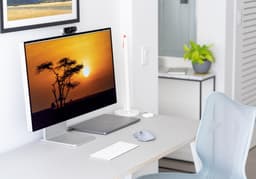
I've had occasional wrist pain for the last few years. I have been able to get by with a good ergonomic keyboard and mouse. For mice, I've been using vertical mice for years. As for keyboards, I've tried a lot of different setups. First, I moved on from my Apple Magic Keyboard to a Keychron K2 mechanical keyboard with a large wristpad. Then I moved on to the slightly thinner Keychron K3.
I still had wrist pain. In particular, I noticed I happened to be straining a lot when reaching for the delete key, for example, when programming. I would find myself doing an unnatural twist to reach it instead of lifting my right hand from the keys.
I started researching more ergonomic keyboards and kept hearing great things about the Kinesis Advantage2. One person even told me this keyboard saved their career. Another told me they had been using the same Kinesis for 18 years. I was sold.


My previous keyboard, the Kinesis Advantage2. Still love it.
I used the Kinesis for 2 or 3 years. I really had no issues with it. My only minor complaints were that the Kinesis Advantage2 doesn't really have any features like Bluetooth, USB-C charging, or LED backlighting, which are table stakes at this point. Instead it has a plain black design, and a boring USB-A cable; no wireless.
Moving to the Glove80
Then I happened to come across the Glove80. It retains the same design as the Kinesis: concave, ortholinear, thumb clusters, split design. But it adds a few more things:
- Lower actuation force keys. This depends on the specific model you purchase, but I got the "Red Pro" keys that have only 35gf of actuation force. The Advantage2 keys were 45gf. Small change but makes a huge difference in my opinion. My hands are less tired after long sessions.
- Extreme customizability with the QMK firmware. You can do things like configure different "layers"
- Lighter and smaller. The Kinesis felt ever so slightly too large for my hands.
- And of course the expected LED backlighting and Bluetooth support for multiple devices
I've had it for some months now and I can't imagine going to anything else. It fits me perfectly, there's loads of customization, and there's less strain on my hands and fingers. That being said, if I had to nitpick it would be that the keyboard halves are too lightweight and move around on my desk at times, and that the keys themselves feel a bit too smooth and wish they were a bit more grippy as it feels like my fingers can slide off.

The Glove80 also comes with a travel case.
Steep learning curve
If you end up moving to the Glove80 or a similar keyboard (Kinesis Advantage360, ZSA Moonlander keyboard, etc) there's a steep learning curve, so you'll have to give it time. There's a few things to get used to:
-
Ortholinear: Keys are stacked vertically, not staggered. For example, the S key is directly under the W key, not staggered off to the side. This took at least a week to get used to.
-
Concave: You don't have to reach as much as your fingers sort of go into a well. So reaching a lower key like C feels more natural.
-
Split design: Like other ergonomic keyboards, the keys are split into two halves, with a sizable space in the middle. This helps so that your arms don't have to unnaturally come closer together, and thus cause you to twist your wrists.
-
Thumb clusters: Your thumbs will suddenly become far more productive with this type of keyboard. Instead of only being able to control the spacebar, now each thumb is given duties like Backspace, Command, Alt, Home, End, Page Up/Down and Enter.
One other thing that took a while to get used to was the key layout itself. For example, the arrow keys are split across the two halves. I had strong muscle memory around using them with just my right hand, for example when moving the cursor around while coding. And the general function keys—I missed having dedicated media keys and keys for display brightness. Fortunately, this is easy to modify with the Glove80 Layout Editor. But there's other popular toools like Karabiner Elements too.
It took me a week to get to a normal typing speed, and a few weeks to feel completely at home with this keyboard. The first few days I spent a lot of time practicing my typing on keybr.com.











